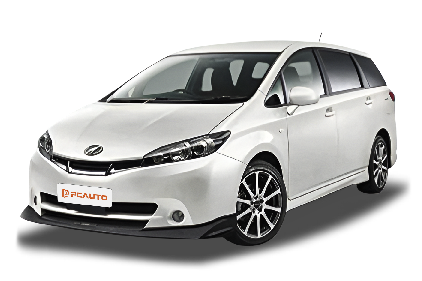Q
What's the Price of the Toyota Wish in Malaysia?
In Malaysia, the Toyota Wish is a discontinued imported MPV. The prices of its used cars vary depending on the vehicle's condition, production year, and configuration. The used car prices for models from 2010 to 2014 are approximately between RM35,000 and RM65,000. The specific price needs to be evaluated based on the mileage, maintenance records, and modification status. This car is well-known for its practical interior space and reliability. It is equipped with a 1.8L or 2.0L engine, making it a great choice for family users. However, it should be noted that the parts cost of imported cars is relatively high. It is recommended to have the vehicle inspected by PUSPAKOM and check the import information from the Royal Malaysian Customs Department (JKDM) before purchasing. If you're considering a new car in the same class, you can refer to locally assembled (CKD) models such as the Toyota Sienta or the Honda BR - V. These models come with lower maintenance costs and original factory warranties. As for used-car options, there are also Japanese MPVs like the Nissan Grand Livina. It is advisable to make a comprehensive comparison based on your budget and requirements.
Special Disclaimer: This content is published by users and does not represent the views or position of PCauto.
Related Q&A
Q
How much fuel does a Toyota Wish use per km?
The fuel consumption of the Toyota Wish varies depending on the model year, engine displacement (such as 1.8L or 2.0L), and driving conditions. According to actual data, the combined fuel consumption of the 1.8L model is around 0.08 to 0.10 Malaysian Ringgit per kilometer (approximately 6.5 to 8.0 liters per 100 kilometers based on the current oil price). The 2.0L model has slightly higher consumption, about 0.10 to 0.12 Malaysian Ringgit per kilometer (8.0 to 9.5 liters per 100 kilometers).
The actual fuel consumption may be affected by road conditions, air - conditioning usage, and driving habits. For example, frequent rapid acceleration or traffic congestion in the city can significantly increase fuel consumption. It is recommended that car owners perform regular maintenance (such as replacing air filters and spark plugs) and maintain proper tire pressure to optimize fuel efficiency.
The oil price in Malaysia fluctuates greatly. You can refer to the fuel consumption test data published by MyJPJ or SPAD. Hybrid models are usually more fuel - efficient, but Toyota has not launched a hybrid version of the Wish. If you are considering energy - saving options, you can compare models in the same class, such as the Honda Jazz Hybrid or the Toyota Corolla Cross Hybrid.
Q
How many trims does the Toyota Wish have?
The Toyota Wish is available in three trim levels: the 2017 Toyota Wish 2.0L Z, the 2017 Toyota Wish 1.8L X, and the 2017 Toyota Wish 2.0L G. While these trims share many core features, there are some differences in specific details. For instance, the 2.0L Z weighs 1,420 kg, the 1.8L X weighs 1,340 kg, and the 2.0L G weighs 1,380 kg. In terms of seating capacity, the 2.0L Z offers six seats, whereas the 1.8L X and 2.0L G provide seating for seven. The body dimensions also vary slightly: the 2.0L Z measures 1,745 mm in width and 1,600 mm in height, while the 1.8L X and 2.0L G are 1,695 mm wide and 1,590 mm high.
Despite these differences, the three trims share several key specifications. All versions feature a CVT transmission, front-wheel drive, and an official combined fuel consumption of 6.9 L/100 km. Additionally, each model comes equipped with a comprehensive range of safety and convenience features.
Q
What is the maintenance schedule for Toyota Wish?
It is recommended that the Toyota Wish undergo regular maintenance every 6 months or every 10,000 kilometers, whichever comes first. This is the standard set by Toyota officially for the tropical climate and road conditions in Malaysia. Basic maintenance includes changing the engine oil and oil filter, inspecting the brake system, tire condition, and chassis components. Meanwhile, the air - conditioning filter needs to be cleaned or replaced regularly to cope with the hot and humid environment. The transmission fluid and brake fluid should be checked every 20,000 kilometers. It is advisable to replace the spark plugs and coolant at 40,000 kilometers, and special attention should be paid to the wear of the timing belt or chain at 60,000 kilometers. For Malaysian users, it is especially recommended to shorten the replacement cycle of the air filter, as the dusty environment will accelerate its clogging. It should be noted that the battery pack cooling system of the hybrid version of the Wish requires additional inspection, which is different from that of ordinary fuel - powered vehicles. Strictly following the maintenance manual can not only extend the vehicle's lifespan but also maintain fuel economy. Especially in the frequently congested road conditions in Malaysia, regular maintenance is particularly important for maintaining engine efficiency. If you often drive in coastal areas, you should also increase the frequency of chassis anti - rust inspections, as sea breezes can accelerate the corrosion of metal parts.
Q
How much engine oil does a Toyota Wish require?
The oil capacity of the Toyota Wish depends on the specific year and engine model. Take the common second - generation models from 2009 to 2017 in Malaysia as an example. The version equipped with the 2.0L 3ZR - FE engine usually requires about 4.2 liters of oil (including oil filter replacement), while the 1.8L 2ZR - FE engine needs around 3.8 liters. When actually adding oil, you should refer to the oil dipstick scale. It is recommended to use 5W - 30 fully synthetic oil that meets the API SN standard or higher.
It's worth noting that in Malaysia's tropical climate, you can consider using oil with a slightly higher viscosity, such as 5W - 40, to enhance high - temperature protection. However, you need to follow the suggestions in the original factory manual. Regular oil changes are crucial for engine maintenance. Generally, the oil needs to be changed every 5,000 to 10,000 kilometers or every 6 months. If you often drive short distances or idle for long periods, you should shorten the maintenance cycle. At the same time, I'd like to remind car owners to look for the JASO or ILSAC certification marks when purchasing oil to ensure the quality.
Q
What is the best engine oil for Toyota Wish?
For the Toyota Wish, the most suitable engine oils are 5W - 30 or 10W - 30 fully synthetic oils that meet Toyota's original factory standards. These two viscosities can provide excellent lubrication performance and fuel economy under Malaysia's climatic conditions. In particular, the high - temperature stability and oxidation resistance of fully synthetic oils are more suitable for tropical climates, and they can also extend the engine's service life. If the vehicle has high mileage (over 100,000 kilometers), you can consider using high - mileage oils such as 5W - 40 or 10W - 40 to provide better sealing. When choosing engine oil, make sure the product has API SN or SP certification and meets the ILSAC GF - 6 standard. These labels indicate that the oil has reached the current highest international performance standards.
It's worth noting that the oil change interval for the Toyota Wish is generally every 5,000 to 10,000 kilometers or 6 months, depending on driving conditions and the type of oil. Vehicles that often drive in congested urban traffic are recommended to shorten the change interval. Additionally, the quality of the original factory oil filter is more reliable, so it is recommended to replace it when changing the oil. Understanding this knowledge can not only help you better maintain your beloved car but also avoid engine wear problems caused by using improper oil.
Q
What are the advantages of the Toyota Wish?
As a classic 7-seater MPV, the Toyota Wish is highly popular among family users in the Malaysian market. Its advantages mainly lie in practicality and reliability. The spacious and flexible cabin space, combined with the foldable third-row seats, can easily meet the needs of family outings or cargo transportation. The 1.8L and 2.0L Dual VVT-i engines strike a balance between fuel economy and power performance, making them suitable for Malaysia's diverse road conditions.
In addition, Toyota's well-established after-sales service network in the local area and the high resale value of its used cars have also reduced the long-term usage cost. It's worth mentioning that the air - conditioning cooling efficiency of MPV models is particularly important in Malaysia's hot climate, and the Wish's independent rear - row air - conditioning vents are designed with this in mind.
Although there are more new models emerging in the market today, the Wish, with its time - tested durability, remains a practical choice for budget - conscious families. It is especially suitable for users who need to pick up and drop off children frequently or run small businesses.
Q
What type of car is the Toyota Wish?
The Toyota Wish is a sporty MPV. This type of vehicle combines the spatial flexibility of an MPV with the driving experience of a sports car, offering users a unique driving option. The Toyota Wish has a length of 4,590mm, a width ranging from 1,695 to 1,745mm, a height between 1,590 and 1,600mm, and a wheelbase of up to 2,750mm. Its size design makes the interior space spacious and practical. It comes in a 5-door layout with either 6-seat or 7-seat configurations. The rear seats are split and foldable, meeting different needs for passenger-carrying and storage during travel. In terms of power, it offers a choice between 1.8L and 2.0L gasoline engines, paired with a CVT transmission and front-wheel drive, ensuring smooth power delivery during daily driving. Regarding safety features, it is standardly equipped with systems such as ABS anti-lock braking, lane departure warning, and active braking, along with 8 airbags, providing reliable safety protection for both drivers and passengers.
Q
What is the safety rating of the Toyota Wish?
The Toyota Wish performs averagely in safety ratings. According to past test records, this model has achieved above-average results in safety assessments in some regions. However, the specific ratings may vary depending on different testing agencies and model years. In the Malaysian market, the Toyota Wish is favored by many family users for its practical space and reliability. It should be noted, though, that earlier models may not be equipped with the latest active safety technologies, such as automatic emergency braking or lane-keeping assist. For safety-conscious consumers, it is recommended to thoroughly understand the safety equipment of the specific year and configuration before purchasing. You can also refer to the data of regional safety evaluation institutions like ASEAN NCAP. The road conditions in Malaysia are diverse. Whether you're driving in the city or on a long trip, it's extremely important to choose a vehicle with good safety performance. Besides paying attention to crash ratings, daily vehicle maintenance and safe driving habits should not be ignored either.
Q
Does Toyota Wish have a timing belt or chain?
The models of the Toyota Wish launched in the Malaysian market are mainly equipped with 1.8 - liter and 2.0 - liter gasoline engines. Both of these two engines adopt the timing chain design instead of the timing belt. The advantage of the timing chain is that it has a longer lifespan. Usually, it can last for the entire life cycle of the engine without replacement, which reduces the long - term maintenance cost. On the other hand, the timing belt needs to be regularly inspected and replaced at around 60,000 to 100,000 kilometers to avoid the risk of breakage. For Malaysian car owners, the timing chain is more suitable for the local hot and rainy climate because it has better resistance to high temperatures and humidity. However, it is still recommended to regularly check whether the chain tensioner is working properly. It should be noted that although the chain is maintenance - free, if the engine makes abnormal noises (such as metal friction sounds), it should be repaired in time, which is the same for all models with chain - driven systems. In addition, car owners can further confirm the specific configuration through the vehicle manual or the markings in the engine compartment. There may be slight differences in the Wish models of different years.
Q
How fast is Toyota Wish?
The Toyota Wish is a popular 7-seater MPV in Malaysia. Its power performance depends on the specific model and engine configuration. The early models are equipped with 1.8-liter or 2.0-liter naturally aspirated engines. The 1.8-liter version has a maximum horsepower of about 132 hp, while the 2.0-liter version can reach about 141 hp. It takes about 10-12 seconds to accelerate from 0 to 100 km/h, and the top speed is about 180-190km/h. It's suitable for family use. Although it's not known for its sporty performance, the smooth CVT transmission and comfortable suspension tuning make it perform well in city driving and long-distance trips. It's worth noting that the design of this kind of MPV focuses more on space utility and fuel economy rather than ultimate speed. For Malaysian consumers, the reliability and low maintenance cost of the Wish are also important reasons for its popularity. If you have higher requirements for performance, you can consider the sporty models of the same brand. But as a family car, the Wish strikes a good balance between power and practicality.
Latest Q&A
Q
How much is a Toyota Harrier 2023?
The 2023 Toyota Harrier is priced locally between approximately RM200,000 and RM250,000, varying by trim level and configuration. Exact prices may fluctuate depending on dealer promotions or optional accessories. The vehicle offers two powertrain options: a 2.0-liter naturally aspirated engine and a 2.5-liter hybrid system. The hybrid variant stands out for its fuel efficiency, making it ideal for eco-conscious buyers. The Harrier has gained popularity for its sleek exterior design, spacious interior, and generous tech features – like the standard Toyota Safety Sense suite, which includes pre-collision safety, lane departure alert, and other functions. Notably, it shares a platform with the Lexus NX, resulting in a solid driving experience. Recent fluctuations in the Japanese Yen exchange rate could impact import vehicle pricing, so it’s advisable to compare quotes from multiple authorized dealers before purchasing. Keep an eye out for promotional offers or low-interest financing deals too. Besides the Harrier, competitors in the same price range include the Honda CR-V and Mazda CX-5, each with distinct strengths in space, power, or handling.
Q
How much is a 2020 Mitsubishi Triton worth?
The current used market price for the 2020 Mitsubishi Triton ranges from approximately RM65,000 to RM95,000, with the exact price depending on factors such as vehicle condition, mileage, trim level, and whether it still has the original factory warranty. For example, higher-spec Triton Adventure variants or models equipped with four-wheel drive systems typically command higher prices. This pickup truck is renowned for its durability and off-road capabilities, powered by a 2.4-liter turbocharged diesel engine that delivers 181 horsepower and 430 Nm of torque, paired with either a 6-speed manual or automatic transmission, making it suitable for both daily commuting and outdoor adventures. In the used market, the Triton maintains relatively stable resale value, but it is advisable to have a professional inspection to check the condition of the engine, transmission, and chassis before purchasing, while also reviewing maintenance records to ensure there have been no major accidents. If on a tighter budget, considering 2018-2019 model years could save RM10,000 to RM20,000, though note that some of these may be approaching the end of their warranty period. Additionally, Mitsubishi's extensive after-sales service network and ample parts supply result in lower long-term ownership costs, which is one of the reasons the Triton remains popular in the used market.
Q
How much can a 2020 Mitsubishi Triton tow?
The towing capacity of the 2020 Mitsubishi Triton depends on the specific trim and configuration, but generally, it maxes out around 3.1 tonnes. That’s enough for most everyday towing jobs—think small boats, camper trailers, or building materials. Under the hood, this pickup packs a 2.4-liter turbo diesel engine, which dishes out plenty of low-end torque. Paired with either a 6-speed manual or automatic transmission, it keeps power delivery steady even when hauling heavy loads.
A quick heads-up: when you’re actually towing, you’ve got to factor in weight distribution, road conditions, and how well-maintained your truck is. It’s smart to regularly check the brakes and cooling system to stay safe out there. If you’re towing heavy stuff often, consider adding the factory-recommended accessories—things like a trailer stability system or electronic brake controller can really up the safety game. And if you need to tow something even heavier? Best to check the owner’s manual or hit up your dealer to confirm your specific model’s limits. Overloading’s just not worth the risk of damaging your ride.
Q
How much horsepower does a 2020 Triton have?
The 2020 Triton packs 110 horsepower. It's powered by a 2.5-liter (2477cc) diesel engine. This engine cranks out maximum power at 4000 rpm and peak torque at 2000 rpm. It delivers plenty of oomph for daily driving and all sorts of tasks, letting the truck handle different road conditions and payload demands with ease. There might be some performance variations across different trims, but overall, they all offer a reliable and practical driving experience.
Q
What is the fuel consumption of a Mitsubishi Triton 2020?
The fuel economy of the 2020 Mitsubishi Triton varies depending on the specific trim and driving conditions. Official figures show that the version equipped with the 2.4-liter MIVEC turbocharged diesel engine (model 4N15) has a combined fuel consumption of approximately 8.6 liters per 100 kilometers. Manual transmission models might be slightly lower at 8.2 liters per 100 kilometers, while automatic variants tend to be a bit higher due to transmission tuning. In real-world driving, if you frequently carry heavy loads or go off-roading, fuel consumption could rise to 10-12 liters per 100 kilometers. This engine features common rail injection technology and a variable geometry turbocharger, balancing low-end torque with high-rev efficiency. The accompanying Super Select 4WD-II system maintains decent fuel economy even in 4H mode. It's important to note that diesel vehicle fuel consumption is significantly affected by fuel quality; using B7 or higher-grade diesel is recommended to achieve optimal performance. Additionally, regular maintenance of the fuel filter and injectors is crucial for keeping fuel consumption in check. Rivals in the same pickup segment like the Toyota Hilux and Ford Ranger have similar fuel economy figures, but the Triton's lightweight chassis design gives it a slight edge when unladen. Adding a bed cover or reducing highway cruising RPM can further optimize fuel efficiency.
View MoreRelated News

Toyota Supra (A90) will be discontinued next March, and the next generation model may be led by Toyota.
JohnNov 14, 2025

Which one is better, Honda City or Toyota Vios?
AshleyNov 11, 2025

2026 Toyota Hilux Travo released, the brand-new exterior and interior are highly anticipated
LienNov 11, 2025

Should I choose the top-tier Toyota Corolla Cross, or the entry-level Fortuner?
Kevin WongNov 6, 2025

Why are people more willing to choose Toyota Hilux instead of Isuzu D-Max?
JamesNov 3, 2025
View More


















Pros
Cons